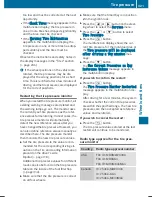
The tires are cold:
R
if the vehicle has been parked without
direct sunlight on the tires for at least three
hours and
R
if the vehicle has been driven for less than
1 mile (1.6 km).
The tire temperature changes depending on
the outside temperature, the vehicle speed
and the tire load. If the tire temperature
changes by 18 ‡ (10 †), the tire pressure
changes by approximately 10 kPa (0.1 bar/
1.5 psi). Take this into account when check-
ing the pressure of warm tires. Only correct
the tire pressure if it is too low for the current
operating conditions. If you check the tire
pressure when the tires are warm, the result-
ing value will be higher than if the tires were
cold. This is normal. Do not reduce the tire
pressure to the value specified for cold tires.
The tire pressure would otherwise be too low.
Observe the recommended tire pressures for
cold tires:
R
on the Tire and Loading Information placard
on the B-pillar on the driver's side
R
in the tire pressure table on the inside of the
fuel filler flap
R
printed in yellow on the rim of the emer-
gency/collapsible spare wheel (depending
on vehicle equipment)
Underinflated or overinflated tires
Underinflation
G
WARNING
Tires with pressure that is too low can over-
heat and burst as a consequence. In addition,
they also suffer from excessive and/or irreg-
ular wear, which can severely impair the brak-
ing properties and the driving characteristics.
There is a risk of an accident.
Avoid tire pressures that are too low in all the
tires, including the spare wheel.
Underinflated tires may:
R
overheat, leading to tire defects
R
have an adverse effect on handling charac-
teristics
R
wear quickly and unevenly
R
have an adverse effect on fuel consumption
Overinflation
G
WARNING
Tires with excessively high pressure can burst
because they are damaged more easily by
road debris, potholes etc. In addition, they
also suffer from irregular wear, which can
severely impair the braking properties and the
driving characteristics. There is a risk of an
accident.
Avoid tire pressures that are too high in all the
tires, including the spare wheel.
Overinflated tires may:
R
increase the braking distance
R
have an adverse effect on handling charac-
teristics
R
wear quickly and unevenly
R
have an adverse effect on ride comfort
R
be more susceptible to damage
Maximum tire pressures
:
Example: maximum permissible tire pres-
sure
Never exceed the maximum permissible tire
inflation pressure. Always observe the rec-
ommended tire pressure for your vehicle
316
Tire pressure
Wheels
and
tires
Содержание 2015 SLK
Страница 4: ......
Страница 40: ...38 ...
Страница 72: ...70 ...
Страница 73: ...Useful information 72 SmartKey 72 Doors 78 Trunk 80 Side windows 83 Roof 87 71 Opening and closing ...
Страница 138: ...136 ...
Страница 257: ...Useful information 256 Stowage areas 256 Features 258 255 Stowage and features ...
Страница 278: ...276 ...
Страница 279: ...Useful information 278 Engine compartment 278 ASSYST PLUS 282 Care 283 277 Maintenance and care ...
Страница 292: ...290 ...
Страница 310: ...308 ...
Страница 357: ...355 ...
Страница 358: ...356 ...
















































